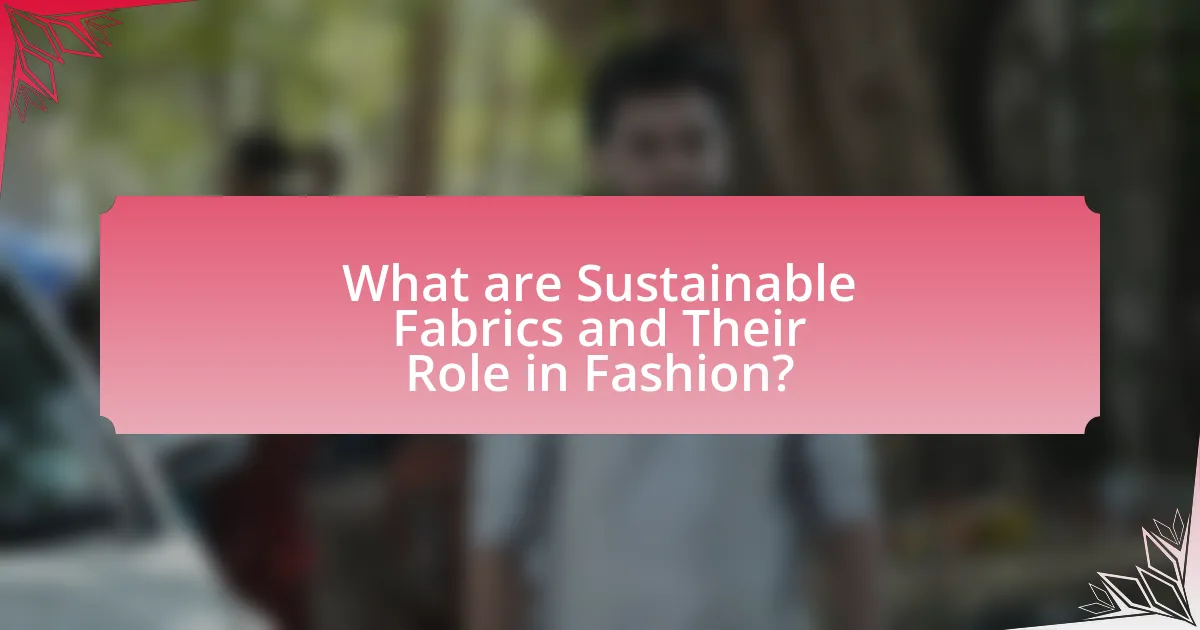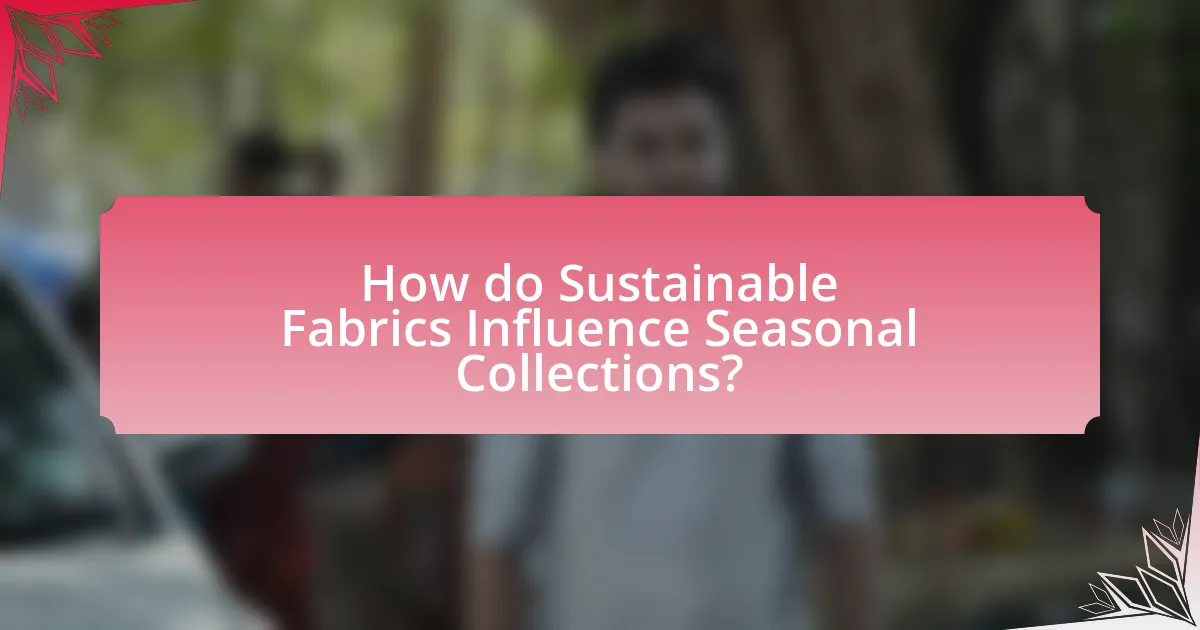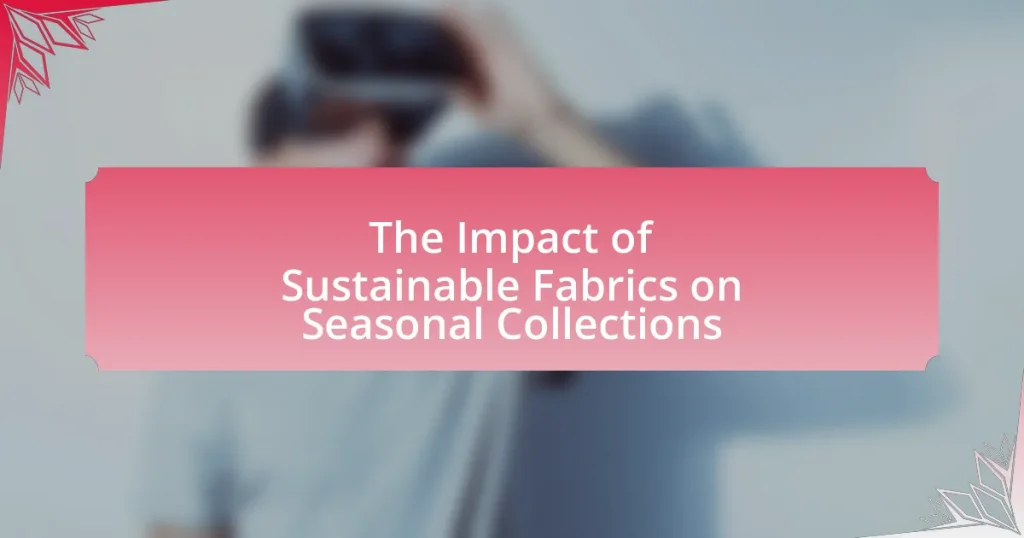Sustainable fabrics, defined as materials produced with minimal environmental impact using organic, recycled, or renewable resources, play a crucial role in the fashion industry by reducing waste and promoting ethical production practices. This article explores the differences between sustainable and traditional fabrics, the types of materials classified as sustainable, and the environmental issues they address. It also examines how consumer demand influences the adoption of sustainable fabrics in seasonal collections, the challenges brands face in integrating these materials, and the future implications of technological advancements on sustainable fabric production. Key trends, best practices, and strategies for effective communication regarding sustainability in fashion are also discussed, highlighting the importance of these practices for both brands and consumers.

What are Sustainable Fabrics and Their Role in Fashion?
Sustainable fabrics are materials produced with minimal environmental impact, often using organic, recycled, or renewable resources. Their role in fashion is significant as they contribute to reducing waste, lowering carbon footprints, and promoting ethical production practices. For instance, organic cotton uses 91% less water than conventional cotton, and recycled polyester diverts plastic waste from landfills. The adoption of sustainable fabrics in seasonal collections reflects a growing consumer demand for eco-friendly options, influencing brands to innovate and prioritize sustainability in their designs.
How do sustainable fabrics differ from traditional fabrics?
Sustainable fabrics differ from traditional fabrics primarily in their production processes and environmental impact. Sustainable fabrics are made from renewable resources, such as organic cotton or recycled materials, which significantly reduce carbon emissions and water usage compared to traditional fabrics, often derived from petroleum-based sources. For instance, the production of organic cotton uses 91% less water than conventional cotton farming, according to the Textile Exchange’s 2021 report. Additionally, sustainable fabrics often employ eco-friendly dyes and processes that minimize pollution, whereas traditional fabrics may involve harmful chemicals that contribute to environmental degradation.
What materials are classified as sustainable fabrics?
Sustainable fabrics include materials such as organic cotton, hemp, Tencel (lyocell), recycled polyester, and bamboo. These fabrics are classified as sustainable due to their lower environmental impact during production and their ability to be sourced from renewable resources. For instance, organic cotton is grown without synthetic pesticides or fertilizers, significantly reducing soil and water pollution. Hemp requires minimal water and no pesticides, making it a highly sustainable crop. Tencel is produced from sustainably sourced wood pulp and is biodegradable, while recycled polyester diverts plastic waste from landfills, contributing to a circular economy. Bamboo grows rapidly and absorbs carbon dioxide, further enhancing its sustainability credentials.
How do production processes impact sustainability in fabrics?
Production processes significantly impact sustainability in fabrics by determining resource efficiency, waste generation, and environmental footprint. For instance, conventional textile manufacturing often involves high water consumption and chemical usage, leading to pollution and resource depletion. In contrast, sustainable production methods, such as using organic materials and eco-friendly dyes, reduce harmful emissions and conserve water. According to a report by the Ellen MacArthur Foundation, transitioning to circular production processes can decrease fabric waste by up to 80%, highlighting the importance of adopting sustainable practices in the textile industry.
Why is sustainability important in the fashion industry?
Sustainability is important in the fashion industry because it addresses environmental degradation and promotes ethical practices. The fashion industry is one of the largest polluters globally, contributing to significant waste and carbon emissions. For instance, according to the Ellen MacArthur Foundation, the fashion sector is responsible for 10% of global carbon emissions and generates 92 million tons of waste annually. By adopting sustainable practices, such as using eco-friendly materials and reducing waste, the industry can mitigate its negative impact on the planet and promote a circular economy. This shift not only benefits the environment but also meets the growing consumer demand for responsible and ethical fashion choices.
What environmental issues are addressed by using sustainable fabrics?
Sustainable fabrics address several environmental issues, primarily reducing pollution, conserving water, and minimizing waste. By utilizing organic materials and eco-friendly production processes, sustainable fabrics significantly lower the release of harmful chemicals into waterways, which is a major contributor to water pollution in the textile industry. For instance, conventional cotton farming uses approximately 7,000 liters of water to produce just one kilogram of cotton, whereas organic cotton uses significantly less water due to its farming practices. Additionally, sustainable fabrics often incorporate recycled materials, which helps divert waste from landfills and reduces the demand for virgin resources. This approach not only mitigates the environmental impact of textile production but also promotes a circular economy, where materials are reused and repurposed.
How does consumer demand influence the adoption of sustainable fabrics?
Consumer demand significantly influences the adoption of sustainable fabrics by driving manufacturers to prioritize eco-friendly materials in response to consumer preferences. As awareness of environmental issues grows, consumers increasingly seek products that align with their values, leading brands to adopt sustainable practices to meet this demand. For instance, a 2021 survey by McKinsey & Company found that 67% of consumers consider sustainability when making a purchase, prompting brands to integrate sustainable fabrics into their collections to attract and retain customers. This shift not only reflects changing consumer values but also encourages innovation in sustainable textile production, further accelerating the adoption of these materials in the fashion industry.

How do Sustainable Fabrics Influence Seasonal Collections?
Sustainable fabrics significantly influence seasonal collections by driving design innovation and consumer demand for eco-friendly options. Designers increasingly incorporate materials like organic cotton, Tencel, and recycled polyester into their collections, aligning with the growing consumer preference for sustainability. According to a 2021 McKinsey report, 67% of consumers consider sustainability when making a purchase, prompting brands to adapt their seasonal offerings to include sustainable fabrics. This shift not only enhances brand reputation but also meets regulatory pressures and market trends favoring environmentally responsible practices.
What trends are emerging in seasonal collections due to sustainable fabrics?
Emerging trends in seasonal collections due to sustainable fabrics include increased use of organic materials, innovative recycling techniques, and a focus on minimalistic designs. Brands are increasingly adopting organic cotton, hemp, and Tencel, which are known for their lower environmental impact compared to conventional fabrics. Additionally, the rise of upcycled materials is reshaping collections, as designers incorporate recycled textiles to reduce waste. This shift is supported by consumer demand for transparency and ethical production, with a 2021 survey indicating that 66% of global consumers are willing to pay more for sustainable brands. These trends reflect a broader commitment within the fashion industry to sustainability and environmental responsibility.
How do designers incorporate sustainable fabrics into their seasonal lines?
Designers incorporate sustainable fabrics into their seasonal lines by selecting materials that are environmentally friendly, such as organic cotton, recycled polyester, and Tencel. These fabrics are chosen for their reduced environmental impact, as they often require less water and energy to produce compared to conventional materials. For instance, organic cotton uses 91% less water than traditional cotton farming, making it a more sustainable choice. Additionally, designers often collaborate with suppliers who specialize in sustainable textiles, ensuring that their collections align with eco-friendly practices. This approach not only meets consumer demand for sustainable fashion but also contributes to the overall reduction of the fashion industry’s carbon footprint.
What challenges do brands face when integrating sustainable fabrics into collections?
Brands face several challenges when integrating sustainable fabrics into collections, primarily related to sourcing, cost, and consumer perception. Sourcing sustainable fabrics can be difficult due to limited availability and the need for reliable suppliers who adhere to environmental standards. Additionally, sustainable materials often come with higher production costs, which can impact pricing strategies and profit margins. Consumer perception also poses a challenge, as some customers may not fully understand the benefits of sustainable fabrics or may be hesitant to pay a premium for them. These factors collectively hinder brands from seamlessly incorporating sustainable fabrics into their seasonal collections.
How do sustainable fabrics affect the lifecycle of seasonal collections?
Sustainable fabrics significantly extend the lifecycle of seasonal collections by reducing environmental impact and promoting resource efficiency. These fabrics, often made from organic or recycled materials, minimize waste and energy consumption during production, which leads to a lower carbon footprint. For instance, a study by the Ellen MacArthur Foundation highlights that using recycled polyester can reduce energy consumption by up to 75% compared to virgin polyester. Additionally, sustainable fabrics often possess greater durability, allowing garments to withstand multiple seasons, thereby encouraging consumers to invest in quality over quantity. This shift not only enhances the longevity of collections but also aligns with growing consumer demand for environmentally responsible fashion, ultimately fostering a more sustainable industry.
What impact do sustainable fabrics have on production timelines?
Sustainable fabrics generally extend production timelines due to their sourcing and processing requirements. The production of sustainable materials often involves more complex supply chains, which can lead to longer lead times compared to conventional fabrics. For instance, organic cotton requires specific farming practices that take longer to cultivate, and recycled materials may need additional processing to ensure quality. According to a study by the Textile Exchange, the transition to sustainable practices can increase production time by 20-30% as manufacturers adapt to new sourcing and processing methods.
How do sustainable fabrics influence consumer purchasing decisions during seasonal sales?
Sustainable fabrics significantly influence consumer purchasing decisions during seasonal sales by increasing the perceived value of products. Research indicates that 66% of global consumers are willing to pay more for sustainable brands, reflecting a growing preference for environmentally friendly options. This trend is particularly pronounced during seasonal sales, where consumers often seek to align their purchases with their values, opting for sustainable fabrics that promise lower environmental impact. Additionally, brands that emphasize sustainability in their marketing during these sales periods can enhance consumer trust and loyalty, further driving purchasing decisions.

What are the Future Implications of Sustainable Fabrics on Seasonal Collections?
The future implications of sustainable fabrics on seasonal collections include a significant shift towards eco-friendly materials, which will redefine design practices and consumer expectations. As brands increasingly adopt sustainable fabrics, such as organic cotton and recycled polyester, they will likely prioritize transparency in sourcing and production processes. This shift is supported by a growing consumer demand for environmentally responsible fashion, with a 2021 McKinsey report indicating that 67% of consumers consider sustainability when making a purchase. Consequently, seasonal collections will evolve to feature innovative designs that emphasize durability and versatility, reducing waste and promoting a circular economy.
How might technological advancements shape the future of sustainable fabrics?
Technological advancements will significantly shape the future of sustainable fabrics by enabling the development of innovative materials that reduce environmental impact. For instance, advancements in biotechnology allow for the creation of bio-based fabrics, such as those derived from algae or agricultural waste, which can minimize reliance on petroleum-based fibers. Additionally, improvements in recycling technologies facilitate the efficient processing of post-consumer textiles, transforming them into new fabrics and reducing landfill waste. According to a report by the Ellen MacArthur Foundation, the fashion industry could reduce its greenhouse gas emissions by 44% by 2030 through the adoption of circular economy practices, which are supported by these technological innovations.
What innovations are currently being explored in sustainable fabric production?
Innovations currently being explored in sustainable fabric production include the development of bio-based materials, such as fabrics made from agricultural waste, and the use of recycled fibers, particularly from post-consumer plastics. For instance, companies are creating textiles from pineapple leaves, orange peels, and other byproducts, which reduces waste and resource consumption. Additionally, advancements in chemical recycling technologies allow for the breakdown of polyester and nylon into their original monomers, enabling the production of new fibers without the need for virgin materials. These innovations are supported by research indicating that using recycled materials can significantly lower carbon emissions and water usage compared to traditional fabric production methods.
How can brands leverage technology to enhance sustainability in seasonal collections?
Brands can leverage technology to enhance sustainability in seasonal collections by utilizing data analytics, sustainable materials, and supply chain transparency. Data analytics enables brands to forecast demand accurately, reducing overproduction and waste. For instance, companies like Zara use advanced algorithms to analyze customer preferences, allowing them to produce only what is needed. Additionally, brands can adopt sustainable materials such as organic cotton or recycled polyester, which significantly lower environmental impact compared to conventional fabrics. According to a report by the Ellen MacArthur Foundation, switching to circular materials can reduce greenhouse gas emissions by up to 70%. Furthermore, implementing blockchain technology enhances supply chain transparency, allowing consumers to trace the origin of materials and ensuring ethical sourcing practices. This combination of technology not only promotes sustainability but also aligns with consumer demand for responsible fashion.
What best practices should brands follow when using sustainable fabrics?
Brands should prioritize transparency and traceability when using sustainable fabrics. This involves sourcing materials from certified suppliers who adhere to environmental and social standards, ensuring that the entire supply chain is accountable. For instance, using organic cotton or recycled polyester can significantly reduce environmental impact, as these materials require less water and energy compared to conventional options. Additionally, brands should engage in lifecycle assessments to evaluate the environmental effects of their products from production to disposal. Research indicates that sustainable practices can enhance brand loyalty, with 66% of consumers willing to pay more for sustainable brands, according to a Nielsen report. By implementing these best practices, brands can effectively contribute to sustainability while appealing to environmentally conscious consumers.
How can brands effectively communicate their sustainable practices to consumers?
Brands can effectively communicate their sustainable practices to consumers by utilizing transparent messaging and engaging storytelling. Transparency involves providing clear information about sourcing, production processes, and environmental impact, which builds trust. For instance, brands can share data on carbon emissions reductions or water savings achieved through sustainable practices. Engaging storytelling can highlight the journey of sustainable fabrics from raw materials to finished products, making the information relatable and memorable. Research indicates that 66% of consumers are willing to pay more for sustainable brands, emphasizing the importance of effective communication in influencing purchasing decisions.
What strategies can be implemented to ensure the longevity of sustainable fabrics in fashion?
To ensure the longevity of sustainable fabrics in fashion, brands should implement strategies such as investing in high-quality materials, promoting proper care instructions, and adopting circular fashion principles. High-quality sustainable fabrics, like organic cotton or Tencel, are more durable and can withstand wear and tear, thus extending their lifespan. Providing consumers with clear care instructions can prevent damage and maintain the fabric’s integrity over time. Additionally, adopting circular fashion principles, such as recycling and upcycling, encourages the reuse of materials, reducing waste and promoting sustainability. Research indicates that durable materials can reduce the frequency of purchases, leading to a lower environmental impact (Ellen MacArthur Foundation, “A New Textiles Economy: Redesigning Fashion’s Future,” 2017).














